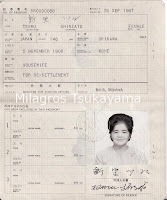Location of Okinawa, south of Japan
Dentro de un par de meses, el 23 de marzo se conmemorará el "Irei no Hi” (慰霊の日, en español: "día en memoria de los caídos"), que fue una de las guerras más sangrientas de la historia de Japón, pero que ocurrió en una de sus más bellas islas, Okinawa. Muchos habrán escuchado de Iwo Jima, por la película “Cartas desde Iwo Jima”, dirigida por Clint Eastwood en el 2006, pero muchos seguramente ignoran la batalla que la precedió, la de Okinawa.
El 1ro de abril de 1945 empezó la Batalla de Okinawa, en donde las fuerzas japonesas lucharon contra la armada norteamericana, en una batalla que duró dos meses. Una lucha encarnizada y en donde murieron más personas (entre soldados y población civil) que en los bombardeos de Hiroshima y Nagasaki juntos.
Muertos a causa de los ataques, por inanición o por suicidios colectivos.
Denominada también “Operación Iceberg” por la crueldad y rapidez de las maniobras que terminaron con la victoria norteamericana y la instalación de sus bases militares, fue una batalla que tuvo como objetivo el dominio del Pacífico y de Japón.
Cuando terminó la Segunda Guerra mundial, se firma el Tratado de San Francisco o el Tratado de Paz en 1951, en donde las islas Ryukyu, incluyendo Okinawa y otras islas pequeñas, pasan al control administrativo, militar y legislativo de Estados Unidos, y a la vez que se firma un tratado de seguridad, en donde se establecía que las bases militares estadounidenses continuarían en Okinawa.
Este statu quo permaneció hasta 1972, cuando el gobierno norteamericano devolvió Okinawa a la administración japonesa, pero, actualmente, las bases militares norteamericanas permanecen aún en Okinawa y Kanagawa, ¿acaso como un sutil recordatorio?
Las siguientes imágenes corresponden al pasaporte japonés de mi abuela materna, Tsuru Shinzato, quien deseando visitar Okinawa (nuevamente), tuvo que obtener un permiso especial para hacerlo, esto es, una visa expedida por el gobierno estadounidense para permitir su ingreso a Okinawa, en 1967. | |
The following images belong to the Japanese passport of my grandmother on the maternal side, Tsuru Shinzato, who wishing to visit Okinawa (again), she had to obtain a special permission to go there, that means, a visa issued by the American government to allow her entry to Okinawa in 1967. |
A continuación, algunos links de interés:
- Sobre el Tratado de San Francisco, se menciona a las 48 potencias aliadas con los Estados Unidos y en donde se encuentra el Perú: (en español)
http://www.cepc.es/rap/Publicaciones/Revistas/13/RPI_028_153.pdf
http://www.taiwandocuments.org/sanfrancisco01.htm (en inglés)
http://www.taiwandocuments.org/sanfrancisco01.htm (en inglés)
- Museo Conmemorativo de de Okinawa, recuerdo de lo que fue esta batalla: http://www.peace-museum.pref.okinawa.jp/annai/osirase/image/spanish.pdf
- Museo de Himeyuri, en homenaje a las escolares que fungieron de enfermeras para socorrer a los heridos de guerra japoneses:
http://www.okinawa-information.com/content/himeyuri-peacemuseum-itoman (en inglés)
http://www.okinawa-information.com/content/himeyuri-peacemuseum-itoman (en inglés)
http://www.himeyuri.or.jp/guide.html (en japonés)
FUENTES:
Map showing location of Okinawa: http://edition.cnn.com/WORLD/9609/17/briefs/japan.okinawa.lg.map.jpg
Images of passports: Milagros Tsukayama
FUENTES:
Mapa con la ubicación de Okinawa: http://edition.cnn.com/WORLD/9609/17/briefs/japan.okinawa.lg.map.jpg
Imágenes de pasaportes: Milagros Tsukayama
Imágenes de pasaportes: Milagros Tsukayama
Within a couple of months, the "Irei no Hi" (慰霊の日, in English: Okinawa Memorial Day) will be commemorated on March 23th. This was one of the bloodiest battles in the history of Japan, but it took place in one of its most beautiful islands, Okinawa. Many of us would have heard about Iwo Jima, from the movie “Letters from Iwo Jima”, directed by Clint Eastwood in 2006; but probably, many others ignore the preceding battle, the battle of Okinawa.
The battle of Okinawa started on April 1st, 1945, where the Japanese forces fought against the American army, in a two-month battle.
A fierce fight, where died more people (among soldiers and civil population) than in the atomic bombing of Hiroshima and Nagasaki.
They died because of the attacks, starvation or by collective suicides.
This battle was called also “Operation Iceberg” because of its cruelty and quickness of the maneuvers, which came to an end with the American victory and the installation of American military bases on the island. It was a battle whose aim was the control of the Pacific and Japan.
When the Second World War was over, the Treaty of San Francisco or the San Francisco Peace Treaty was signed in 1951. In this treaty, the Ryukyu islands, including Okinawa and other small islands, were handed over to the administrative, military and legislative U.S. control. And at the same time, a treaty of security was signed, where it had established that the American military bases would continue in Okinawa.
This status quo remained until 1972, when the U.S. government gave back Okinawa to the Japanese government, but, nowadays, the American military bases remain still in Okinawa and Kanagawa, (is it like a reminder, then?).
Above, some interesting links:
- About the Treaty of San Francisco, where the 48 U.S. allies are mentioned, including Peru:
http://www.taiwandocuments.org/sanfrancisco01.htmThis status quo remained until 1972, when the U.S. government gave back Okinawa to the Japanese government, but, nowadays, the American military bases remain still in Okinawa and Kanagawa, (is it like a reminder, then?).
Above, some interesting links:
- About the Treaty of San Francisco, where the 48 U.S. allies are mentioned, including Peru:
- The Commemorative Museum of Peace of Okinawa, a memory of what this battle was:
http://www.peace-museum.pref.okinawa.jp/english/index.html
- The Himeyuri Museum, in memoriam of the students who acted as nurses to help the Japanese war-wounded men:http://www.okinawa-information.com/content/himeyuri-peacemuseum-itoman
http://www.himeyuri.or.jp/guide.html (in Japanese)
- The Himeyuri Museum, in memoriam of the students who acted as nurses to help the Japanese war-wounded men:http://www.okinawa-information.com/content/himeyuri-peacemuseum-itoman
http://www.himeyuri.or.jp/guide.html (in Japanese)
SOURCES:
Images of passports: Milagros Tsukayama
ARTÍCULOS RELACIONADOS / RELATED POSTS





No hay comentarios:
Publicar un comentario